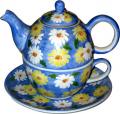Indian tea is a generic term for tea originating from India. Indian tea is also called chai, after the Indian term for tea, although "chai" is used mainly to refer to spiced Indian Tea.
Indian tea usually consists of black tea, and is known for their full-bodied and strong flavor. Indian tea is named after their region of production, and currently there are three main varieties.
Indian tea is sometimes flavored using spices. Common spices include ginger, cardamom, cinnamon, cloves and black peppercorn. Tea that is flavored with these spices is known as Masala Chai.
India is currently one of the world's largest producers of tea, along with Sri Lanka and China.
Varieties of Indian tea
The three main varieties of Indian tea are Assam tea, Nilgiri tea and Darjeeling tea.
Assam tea is produced in the Assam region of Northern India, and is the most-produced Indian Tea. It is a malty, robust tea with a strong, bright color. The leaves have distinctive brown and gold leaves which appear orange when dried. The most prized Assam Tea has golden tips on its leaves, which increases the sweetness of the tea.
Nilgiri tea is produced in the Nilgiri region of southern India. A mountainous region, Nilgiri tea is grown at altitudes of 1000-2500 meters. This variety of Indian tea is known for its smooth taste, amber color and versatility. Nilgiri Tea can be drunk warm or cold, by itself or with milk, and can be used as part of a mixture.
Darjeeling tea is known as the "champagne of teas" and is the finest-quality Indian tea. Grown in West Bengal, Darjeeling tea is known for its distinctive aroma and fragrance. Darjeeling tea is especially famed for its muscatel (grape-like) quality.
There are four varieties of Darjeeling tea, according to its season of harvest. Each variety has its own flavor. The best variety is the Spring Flush, as it has the strongest muscatel quality of the varieties.
